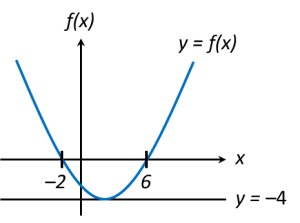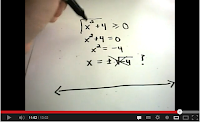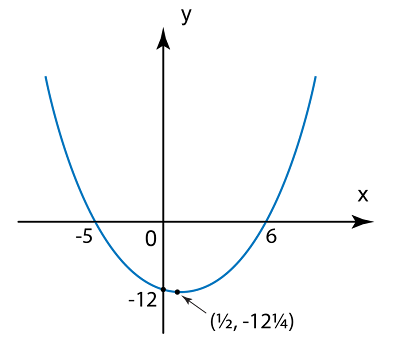Example 1:
Solution:
x+14y=1→(1)y2−8=4x→(2)x=1−14y→(3)
Substitute (3) into (2),
y2−8=4(1−14y)y2−8=4−44y
Substitute the values of y into (3),
when y=−4, x=1−14(−4)=2when y=3, x=1−14(3)=14The solutions are x=2, y=−4 and x=14, y=3
Solve the simultaneous equations.
x+14y=1 and y2−8=4x.
Solution:
x+14y=1→(1)y2−8=4x→(2)x=1−14y→(3)
Substitute (3) into (2),
y2 + y – 12 = 0
(y + 4)(y – 3) = 0
y = –4 or y = 3
Substitute the values of y into (3),
Example 2:
Solution:
From x=−b±√b2−4ac2aa=4, b=−3, c=−4x=−(−3)±√(−3)2−4(4)(−4)2(4)x=3±√738x=−0.693 or 1.443
Solve the simultaneous equations 2x + y = 1 and 2x2+ y2 + xy = 5.
Correct your answer to three decimal places.
Solution:
2x + y = 1-----(1)
2x2 + y2+ xy = 5-----(2)
From (1),
y = 1 – 2x-----(3)
Substitute (3) into (2).
2x2 + (1 – 2x)2 + x(1 – 2x) = 5
2x2 + (1 – 2x)(1 – 2x) + x – 2x2 = 5
1 – 2x – 2x + 4x2 + x – 5 = 0
4x2 – 3x – 4 = 0
From x=−b±√b2−4ac2aa=4, b=−3, c=−4x=−(−3)±√(−3)2−4(4)(−4)2(4)x=3±√738x=−0.693 or 1.443
Substitute the values of x into (3).
When x = –0.693,
y = 1 – 2 (–0.693) = 2.386 (correct to 3 decimal places)
When x = 1.443,
y = 1 – 2 (1.443) = –1.886 (correct to 3 decimal places)
The solutions are x = –0.693, y = 2.386 and x = 1.443, y = –1.886.




















